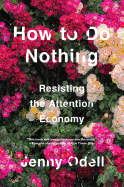
Jenny Odell is an artist who teaches at Stanford University and, like most people in the 21st century, she feels the relentless pull of digital technologies on her already busy life. Targeted advertising, social media, personal brands, the gig economy: these modern manifestations demand attention often to the detriment of their participants, she argues. "In an endless cycle where communication is stunted and time is money, there are few moments to slip away and fewer ways to find each other." How to Do Nothing, however, goes beyond the notions of unplugging and retreat--exercises so often designed to spur greater productivity upon returning. Instead, Odell encourages readers to slow down and cultivate a sense of attention that prioritizes the physical realm.
What makes Odell's approach so appealing is that she recognizes that wholesale permanent retreat is unrealistic; it often neglects a person's responsibility to the world of digital interaction, such as keeping in touch with friends and relatives. Instead, her argument strives for balance, subverting the capitalistic drive of productive content creation by questioning the very terms of its demands. To that end, she draws heavily on Bartleby, the Scrivener, famously declaring, "I would prefer not to." Add to this the finely tuned attentiveness in David Hockney's art, the careful work of Hannah Arendt and a full palette of other brilliant creators, and How to Do Nothing emerges as a lush, sensible argument for balance in an unrelenting world. Furthermore, Odell grounds her work in the natural splendor of her home in the Bay Area. From what better vantage could a writer critique the fallout of Silicon Valley's Internet Age? --Dave Wheeler, associate editor, Shelf Awareness

